Domino Effect
Technical Paper: Oxistop Coatings for Boiler Tube Maintenance
Prepared for the: EPRI: Boiler Tube & HRSG Tube Failures & Inspections International Conference
October 16-18, 2007 • Calgary, Alberta, Canada
Download the PDF of this paper here
Introduction
OXISTOP, LLC, an Ohio based Limited Liability Company, is the sole distributor and applicator of the Oxistop line of ceramic coatings developed specifically for the fossil fuel power generation markets. In May of 2007, Oxistop International, LLC was formed to process the interest and demand for Oxistop Coatings in the international market.
Power generated from fossil fuel combustion relies on boiler tube integrity. Boiler tube failure can be related to the destructive nature of slag, oxidation, corrosion, erosion and abrasion. These issues, Affecting boiler efficiencies and reliability are becoming increasingly important due to the worldwide demand for more power and operational controls related to emissions regulations.
At a fraction of the cost of current alternatives, the Oxistop line of coating materials has been proven to stop or minimize the damage caused by these destructive conditions. As an added benefit of utilizing these materials, boiler tubes coated with Oxistop coatings will maintain optimum heat transfer into boiler water wall tubes by replacing the iron oxide protective (and insulating) layer and residue build-up that occurs when boiler tubes are subjected to high heat and coal combustion with a ceramic based protective barrier. This protective barrier will resist slag buildup that will decrease heat transfer through the boiler tube.
History and Use
Oxistop, LLC was formed in the spring of 2004 (Oxistop International, LLC, formed in 2007) in by a number of partners with extensive power generation maintenance problem solving experience. The company is the exclusive distributor and installer of Oxistop coatings and to date, almost 100,000 square feet of the coating has been installed nationally and worldwide.
As a result of successful early trial applications and high interest in the industry in cost effective solutions to maintenance issues pertaining to boiler reliability, many repeat orders have resulted from over ninety-five (95) initial applications in thirty-three (33) different states and countries.
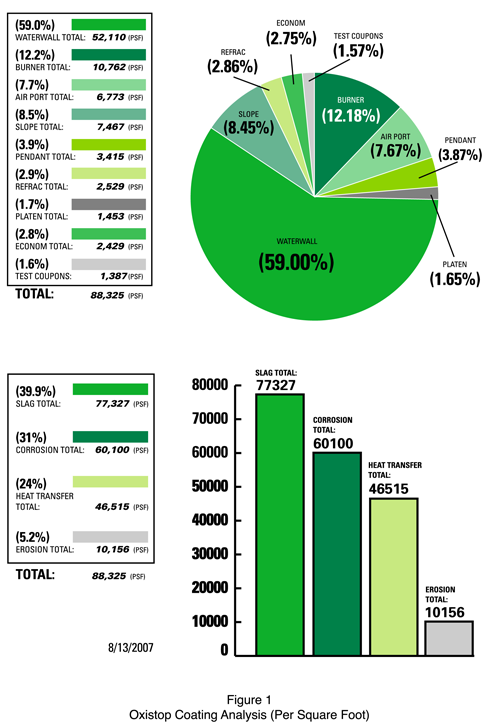
The ability of Oxistop high temperature metal coatings to reduce both, slag and residue buildup, stop corrosion and oxidation and resist fly ash erosion and abrasion has led our client base to evaluate benefit regarding issues in the following areas:
- Burners and over-fired airports—slag and corrosion.
- Refractory doors and burner—slag
- Economizer tubes—corrosion and erosion
- Tube shields and duct supports—corrosion and erosion
- Nose and slope areas—corrosion and slag
- Waterwall areas—corrosion, slag and heat transfer
- Superheat and reheat tubes—fouling, erosion and heat transfer
To date, the types of coals and operations have had little affect on the success in coating material performance. Whether it is eastern or foreign coals, 100% Powder River Basin (PRB) or any blend combination, the materials perform equally well. This is not to say that Oxistop coatings cannot be “tailor made” to meet specific customer needs.
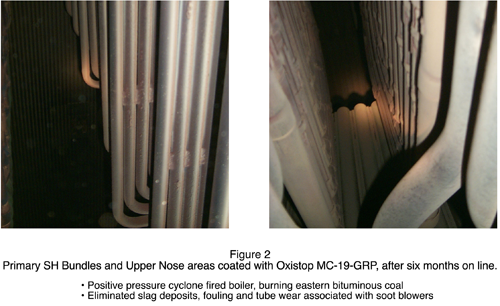
Advantages of Oxistop Coatings on Metal
The advantages of Oxistop coatings compared to other coatings include a history of proven performance in the circulating fluidized bed boiler (CFB) industry for over fifteen (15) years. This material was enhanced and refined for specific applications in the mainstream pulverized coal market in October of 2004. Compared to metallic coatings such as thermal spray or weld overlay, the advantages include not altering the integrity of the tube itself, thereby preventing or hindering future repair work to the tubes as the thermal spray and overlay process will. Stress is not put on the tubes as with an overlay process; in fact Oxistop coatings will improve heat distribution. Oxistop coatings can be removed by grit blasting or grinding if required. Whereas thermal spray and overlay will reduce heat transfer, Oxistop coatings will enhance this process.
Oxistop Coatings Will:
- Reduce the oxidation of metals at high temperatures.
- Improve the temperature uniformity of boiler waterwall tubes.
- Reduce the abrasive wear of fly ash on boiler tubes.
- Reduce the buildup of combustion by-products in pulverized coal burning boilers.
- Improve heat transfer into boiler waterwall tubes.
- Demonstrate excellent corrosion and acid resistance at high temperatures.
- Oxistop coatings are installed 6 to 8 Mils thick and will not crack, chip, or split due to expansion and contraction of the metal substrate. They can be used in conjunction with thermal spray technology, which will provide a cost effective package and act as a sealer for specific and severe applications where the attributes of both, in combination, are an advantage and greater then the whole.
Case Studies
Although boiler runs between planned outages of 12–36 months make evaluation of oxistop coating trials time consuming, a number of repeat applications have been seen based on favorable observations and measurable data. Examples are as follows:
Case Study Number One
In June of 2004, the first trial of Oxistop MC-19-GR coating was installed in a 100 MW boiler burning eastern bituminous coal. A waterwall test area of approximately 120 square feet and two (2) burners of a sixteen-burner wall were selected to evaluate slag-shedding capabilities of the coating. Row “B” burners were identified and coated as eyebrow slagging was heaviest a that level. Economizer tubes were also coated to eliminate corrosion occurrence between tube shields and the tubes.
After one year of boiler operation, the coated burners developed no eyebrows and were slag free. During a planned outage in June of 2005 the coating material was found to be in-tack and continues to be in operation and performing into year three. As a result of this performance, the entire burner wall was coated (16 burners) and has continued to provide to date slag-shedding benefits, in addition to corrosion and erosion wear protection. Oxistop a GY-30 Refractory Coating was utilized to provide a slag shedding protective barrier to the burner refractory. Also coated were additional waterwall areas, for slagging and corrosion, and the underside of the upper slope to eliminate clinker buildup.
Case Study Number Two—Oxistop, Year Two: A Case Study
In April of 2006, Oxistop installed MC-19-GR coating on a 192 MW boiler burning 100% PRB coal. Oxistop prepared by grit blast and coated less than half of the main combustion area and most of the radiant zone of the reheat furnace from below the burners to above the over-fired airports. This totaled a little over 5,500 square feet. The application was comfortably completed in the time allotted.
After approximately twelve days of base line information compiled in March, the preliminary data verified that the application of Oxistop coating enhanced heat transfer in the coated area resulting in an increase in boiler steam output of 5-7 MW. The FEGT (Furnace Exit Gas Temperature) has decreased by 75 degrees. All this has been accomplished burning slightly less coal. The waterwall tubes are cleaner and protected from fly ash erosion, corrosion, slag, and water cannon damage. Payback for the cost of the Oxistop coating application was 24 days. Continual monitoring verifies heat transfer data indicating power output increase remaining constant after more than 1 ½ years on-line as a result of the Oxistop coating application.
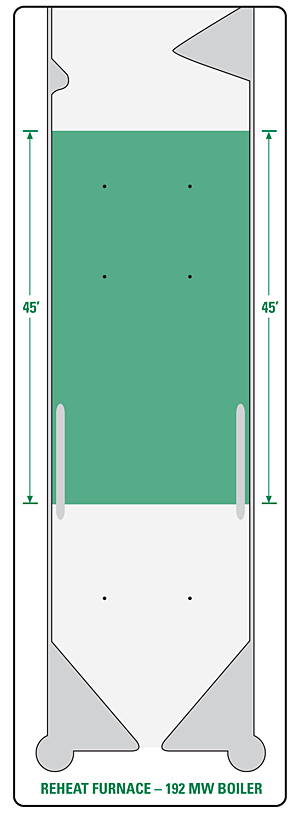

- The water cannon usage in this area is significantly lower.
- The cordial thermocouple rate of delta-t is notably slower and, more significantly, stabilizes at a lower number.
- The furnace exit gas temperatures (FEGT) of the reheat box are below historical data.
- High temp RH and low temp SH thermocouples are below historical data.
- Decrease in air heater outlet gas temperature.
- Lower fuel usage eliminating over firing to make steaming rate.
- Maximum megawatt output is increased to 198 Megawatts, with slightly less coal burned.
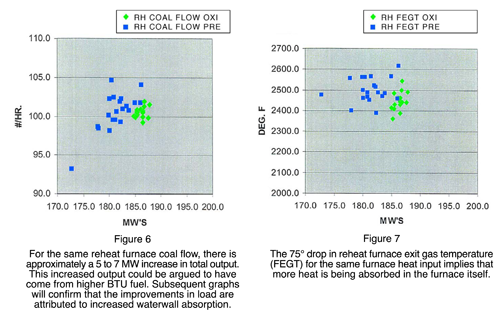
The customer installed an identical 5,520 square foot coating application in the superheat furnace in October of 2006 based on the reheat furnace performance. The tube preparation and coating was accomplished in one twenty four (24) hour period. Benefits were identical to the April reheat furnace application and an additional 8–megawatt pre hour pickup has been realized. In 2007, the customer ordered an additional 17,000 square foot coating application on another boiler, half installed this spring and half scheduled for the fall.
Refractory coating applications
Utilized primarily around burners and refractory lined manway doors, Oxistop GY-30 is a 3,000°F coating material designed to give refractory substrates similar slag shedding characteristics to the Oxistop metal coating.
Recently, Oxistop has developed a system using a unique refractory material that chemically sets without heat and allows the Oxistop GY-30 coating to remain completely bonded after initial refractory curing. This is important during outages where time is of the essence and a “one step” package is required to address refractory repairs as well as the slag protection being sought.
Limitations
Oxistop MC-19-GR is a high temperature, corrosion resistant material that is used on waterwall and related tube apparatus, such as superheat and reheat tubes where the range of steam temperatures are not limiting factors.
It had been used in conjunction with the CFB power industry, beginning in approximately 1990, to minimize fly ash erosion, which approximates a low grade sandblasting affect. When the erosion resistance limits of the ceramic coating are reached, thermal spray technology has been used as a base and packaged with ceramic coating to attain excellent results.
The non-catalytic nature of Oxistop coatings provides a protective barrier that prevents the reaction of combustion by-product adherence to boiler tubes. Upper slope areas and wing-wall tubes are some areas that have demonstrated the limits to the application of Oxistop coatings (not the coating itself) in overcoming slag accumulation due to boiler design issues. On low angle upper slopes, gravity and gas flow patterns can overcome the advantages of this non-catalytic feature and allow for slag to remain a problem. Some wing wall designs that have small gaps between the tubes when surrounded by combustion by-product gas flow streams, allow for slag to bond to itself between the coated tubes to create the base for clinker formation. Coating of these tubes, in this case has shown to have little effect on clinker formation.
Even with these observed occasional operational limitations, slag resistance of Oxistop coatings has been readily demonstrated around burners, over fired airports, on waterwalls, superheat and reheat platen and pendant tubes and the undersides of slope areas. Corrosion, tube wastage and erosion continue to be minimized and in many cases, eliminated by the coating. However, in that these materials rely on an initial heat curing for bonding and strengths, care must be given when the practice of washing down scaffolding after an outage is used. After air-drying and before the heat set the coating will revert back to a wetted state if exposed to water. After initial heat curing the coating becomes resistant to all acids, salts, solvents, water, and alkalies.
Given the range and severity of maintenance issues regarding tube integrity and boiler reliability—overlay technology has, and will remain an option for restoring lost tube wall thickness. Oxistop coatings have been introduced to the power industry to expand the range of options for tube maintenance practices with additional benefits, including cost effectiveness and enhanced heat transfer.
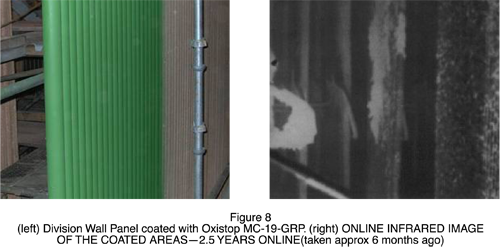
At a cost of approximately one tenth of weld overlay, the industry interest continues to climb regarding both the Oxistop brand of metal and refractory coatings. While not marketed or seen as a cure-all, Oxistop coatings do provide proven alternatives and options to current practices pertaining to high cost maintenance as well as boiler reliability issues. Oxistop coatings are user friendly due to the fact that they are non-toxic, air drying and quickly applied. Curing of the material is accomplished during boiler start-up with no holds or separate heating requirements. Consequently, other repair work in the boiler may continue during the installation process. Expanded use of Oxistop coatings will reduce maintenance costs and increase boiler efficiency and reliability over time. Durability has been demonstrated in initial Oxistop coating trials, beginning in 2004. Each subsequent application has shown staying power, in many cases outage-to-outage, and continued effective performance to date.

Tim E. Batton, President and Senior Managing Member (Contact)
Oxistop International, LLC,
1413 Quaker Circle, Salem Industrial Park
Salem, Ohio 44460 USA
© 2008, OXISTOP, LLC. REFERENCES ARE AVAILABLE UPON REQUEST. This technical paper (White Paper), and other Oxistop archives are available for download at www.oxistop.com.

